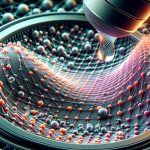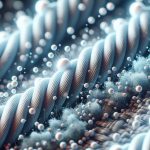Imagine a world where your clothes could do more than just cover you, reminiscent of the sci-fi tales you've heard. With nanotechnology in textiles, this is becoming a reality. By integrating nanomaterials, fabrics are now more durable and water-resistant, even possessing antimicrobial properties. These advancements lead to smart textiles capable of thermal regulation, health monitoring, and even energy harvesting. You might be curious about how these innovations could affect your daily life and the broader implications for sustainability. Let's explore how these groundbreaking technologies are reshaping the fabric of our everyday existence.
Table of Contents
Key Takeaways
- Nanotechnology enhances fabric durability by embedding nanoparticles like silica and carbon nanotubes, significantly boosting strength and longevity.
- Advanced textiles feature water-resistance and self-cleaning properties, reducing the need for frequent washing and extending garment life.
- Anti-microbial textiles incorporating nanomaterials prevent bacterial and fungal growth, improving hygiene and odor control.
- Smart textiles with nanotechnology enable thermal regulation and health monitoring, adapting to user activity and tracking vital signs.
- Sustainable nanotechnology in textiles promotes eco-friendly manufacturing, recycling, and biodegradable materials, reducing environmental impact and waste.
Understanding Nanotechnology
Nanotechnology involves manipulating materials at an atomic or molecular scale, typically less than 100 nanometers in size. By diving into the nanoworld, you can harness unique properties that materials exhibit at these minuscule dimensions. Understanding nanotechnology basics is essential because it opens doors to revolutionary innovations across various fields, including textiles.
When you grasp the fundamental concepts of nanotechnology, you'll see how it can transform everyday materials. For instance, nanoparticles can imbue fabrics with remarkable traits such as enhanced strength, stain resistance, and even antibacterial properties. Imagine a fabric that repels dirt and kills germs on contact—this isn't science fiction but a tangible possibility thanks to nanotechnology.
Moreover, future applications of nanotechnology in textiles are limitless. Picture garments that monitor your health, regulate temperature, or even change color based on your mood. These innovations aren't far off.
Enhanced Fabric Durability
By incorporating nanomaterials, you can dramatically enhance fabric durability, making textiles more resilient to wear and tear. Nanoparticle reinforcement plays a critical role in boosting fabric strength and longevity without compromising flexibility. This cutting-edge approach allows you to create textiles that maintain their integrity even under strenuous conditions.
Nanotechnology enables you to embed nanoparticles like silica, carbon nanotubes, or silver into the fibers of the fabric. These particles form a robust matrix that fortifies the material, increasing its resistance to abrasion and mechanical stress. As a result, your textiles can endure repetitive use and maintain their original appearance for a longer time.
Here's a table to summarize the benefits:
| Aspect | Traditional Textiles | Nanotechnology-Enhanced Textiles |
|---|---|---|
| Fabric Strength | Moderate | High |
| Longevity | Limited | Extended |
| Flexibility | Compromised with strength | Maintained with strength |
| Wear and Tear | High | Low |
Water-Resistant Textiles
Incorporating nanotechnology into textiles allows you to create water-resistant fabrics that repel moisture effectively. By leveraging advanced nanotechnology coatings, you achieve superior performance in water resistance without compromising fabric breathability. These coatings form a protective shield at the molecular level, ensuring water beads off the surface rather than soaking in.
To enhance your understanding, consider the following benefits:
- Enhanced Durability: Nanotechnology coatings improve the longevity of water-resistant properties, reducing the need for frequent reapplications.
- Sustainable Waterproofing: Utilizing nanofibers for waterproofing is eco-friendly, minimizing the environmental impact compared to traditional chemical treatments.
- Improved Comfort: Nanofibers maintain fabric softness and flexibility, ensuring comfort isn't sacrificed for water resistance.
- Versatility: These coatings can be applied to various textiles, from everyday clothing to specialized outdoor gear.
Self-Cleaning Materials
Imagine fabrics that clean themselves, thanks to advanced nanotechnology integrated directly into the textile fibers. With stain resistant fabrics, you won't worry about accidental spills or dirt ruining your clothes. Nanocoating technology creates a protective layer on the fibers, which repels liquids and prevents stains from setting in. This not only extends the life of your garments but also reduces the need for frequent washing, saving resources and time.
Dirt repellent textiles use self cleaning mechanisms to maintain their pristine condition. These mechanisms often involve hydrophobic (water-repelling) and oleophobic (oil-repelling) coatings. When dirt or liquids come into contact with the fabric, they simply roll off the surface, leaving no trace behind.
Here's a quick comparison to help you understand the benefits:
| Feature | Traditional Fabrics | Nanotechnology-Enhanced Fabrics |
|---|---|---|
| Stain Resistance | Low | High |
| Washing Frequency | Frequent | Reduced |
| Durability | Moderate | Enhanced |
Anti-Microbial Properties
Beyond self-cleaning capabilities, nanotechnology in textiles also provides powerful anti-microbial properties that help keep fabrics fresh and hygienic.
By integrating nanoparticles like silver, titanium dioxide, and zinc oxide into fibers, you effectively hinder the growth of bacteria and fungi. This innovation not only enhances fabric preservation but also offers significant benefits in odor control and disease prevention.
Consider these four advantages of anti-microbial textiles:
- Fabric Preservation: Anti-microbial properties extend the lifespan of your textiles by reducing microbial degradation.
- Odor Control: By preventing bacterial growth, these textiles help you maintain a fresh scent, even after prolonged use.
- Disease Prevention: Anti-microbial textiles reduce the risk of infections, making them ideal for medical environments and everyday use.
- Sustainable Textiles: With less frequent washing required, these fabrics contribute to water conservation and reduced detergent use, promoting sustainability.
UV Protection Fabrics
Nanotechnology in textiles offers enhanced UV protection, shielding you from harmful ultraviolet rays. By incorporating nanoparticles like titanium dioxide and zinc oxide into fabrics, textile engineering has revolutionized how we approach sun safety. These nanoparticles provide a high degree of UV resistance without compromising the fabric's breathability or comfort. You can now enjoy outdoor activities without fretting about UV exposure.
Sustainable manufacturing practices are also at the forefront of this innovation. Using eco-friendly processes, manufacturers make certain that the integration of nanotechnology doesn't harm the environment. This approach aligns with the growing consumer demand for sustainable and ethically produced fashion. You're not just getting superior protection; you're also supporting a greener planet.
Fashion trends have quickly embraced UV-protective textiles, offering stylish options that don't sacrifice function for form. From everyday wear to high-end fashion, UV-protective fabrics are becoming a staple. Designers are increasingly creating collections that cater to health-conscious consumers like you, who value cutting-edge technology in their wardrobe.
High-Performance Sportswear
In high-performance sportswear, nanotechnology offers enhanced moisture management, keeping you dry during intense workouts.
You'll also benefit from improved thermal regulation, maintaining a peak body temperature whether you're in the heat or cold.
These advancements guarantee supreme comfort and efficiency in your athletic endeavors.
Enhanced Moisture Management
Imagine you're participating in a marathon, and your high-performance sportswear keeps you dry and comfortable, thanks to advanced moisture management enabled by nanotechnology. This innovation guarantees that your gear excels in fabric breathability and moisture wicking, allowing you to focus solely on your performance.
Nanotechnology enhances sportswear in several critical ways:
- Fabric Breathability: Advanced fabrics incorporate nanoparticle coatings that maintain excellent airflow, reducing the risk of overheating while securing you stay dry.
- Moisture Wicking: Nanoparticles actively draw sweat away from your skin to the fabric's surface, where it can evaporate quickly. This process keeps you feeling fresh and comfortable throughout your run.
- Quick Drying: Nanotechnology enables fabrics to dry at unprecedented speeds. By dispersing moisture rapidly, these textiles prevent the discomfort and weight of sweat-soaked clothing.
- Durability: Nanoparticle coatings enhance the longevity of moisture management properties, guaranteeing your sportswear remains effective through countless washes and intense activities.
Improved Thermal Regulation
When you're pushing your limits, high-performance sportswear with enhanced thermal regulation guarantees you stay at a peak temperature regardless of the conditions. Imagine gear that adapts to your body's needs through smart insulation and nano coatings. These technologies revolutionize climate control, ensuring your thermal comfort is always optimized.
Smart insulation materials adjust to your activities, providing warmth when you're idle and cooling when you're active. Nano coatings, on the other hand, create a barrier that regulates heat flow, making sure you neither overheat nor get too cold. This dynamic duo enables your sportswear to respond intelligently to environmental changes and your physical exertion.
Here's a breakdown of how these innovations work:
| Feature | Function | Benefit |
|---|---|---|
| Smart Insulation | Adapts insulation based on activity levels | Maintains ideal temperature |
| Nano Coatings | Controls heat transfer through fabric | Enhances thermal comfort |
| Climate Control | Responds to external and internal conditions | Keeps you comfortable in all weather |
| Thermal Comfort | Balances warmth and breathability | Reduces overheating and chilling |
Smart Health Monitoring
Smart textiles equipped with nanotechnology can monitor your crucial signs in real-time. These innovations, integrating bio sensing textiles, are revolutionizing remote patient monitoring. Imagine a fabric that not only feels comfortable but also tracks your heart rate, temperature, and even hydration levels. This is the future of wearable health trackers. Smart fabric technologies embed nanosensors within the textile fibers, ensuring seamless health data collection without intrusive devices.
Consider these cutting-edge applications:
- Continuous Health Monitoring: Smart textiles can track essential signs 24/7, providing continuous health data that can be remotely accessed by healthcare providers.
- Early Detection of Health Issues: These textiles can detect anomalies in your vital signs, enabling early intervention and potentially preventing severe health problems.
- Fitness and Performance Tracking: Athletes can use these smart fabrics to monitor their performance metrics in real-time, optimizing training and recovery.
- Chronic Disease Management: For patients with chronic conditions, bio sensing textiles offer a reliable way to manage their health by continuously monitoring critical parameters.
With these innovations, you can elevate your health monitoring to unprecedented levels of precision and convenience, ensuring proactive and informed health management.
Energy-Harvesting Textiles
While smart textiles monitor your health, energy-harvesting textiles generate power from movement, light, or heat, transforming how you stay connected and charged on the go. Imagine a jacket that captures solar energy to charge your phone or running shoes that convert kinetic energy from each step into flexible power for your wearable technology. These innovations aren't just futuristic concepts but practical solutions already taking shape.
You'll find that energy-harvesting textiles incorporate nanomaterials like piezoelectric fibers, which generate electricity through mechanical stress, or photovoltaic nanoparticles that harness solar energy. This integration allows for seamless, flexible power sources embedded into the very fabric you wear daily.
Moreover, this technology aims to make your life more convenient. No more scrambling for a charger; instead, your clothing becomes a sustainable power source. Energy-harvesting textiles exemplify how wearable technology is evolving, offering you both functionality and efficiency.
As you explore these advancements, you'll see the potential for a truly interconnected lifestyle where your garments do more than just cover you — they empower you. By understanding and embracing these textiles, you're not just keeping up with trends; you're mastering the future of wearable tech.
Environmental Impact
Energy-harvesting textiles don't just offer convenience; they also play a significant role in reducing your carbon footprint. These innovative textiles contribute to environmental sustainability in several profound ways that you can utilize in your daily life.
- Sustainable Manufacturing: By employing advanced techniques, manufacturers can create textiles with minimal environmental impact. This often involves using renewable energy sources and reducing waste.
- Recycling Technologies: Modern recycling technologies guarantee that old textiles can be reprocessed into new, high-quality products, thereby reducing the need for virgin materials.
- Biodegradable Nanomaterials: These materials break down naturally, minimizing landfill waste and reducing pollution. You can choose products made from these materials to support eco-friendly applications.
- Eco-Friendly Applications: Textiles enhanced with nanotechnology can have extended lifespans and improved functionality, reducing the frequency of replacements and further decreasing waste.
Frequently Asked Questions
How Does Nanotechnology Affect the Cost of Textile Production?
A penny saved is a penny earned. You'll find nanotechnology enhances cost efficiency in production processes, streamlines the supply chain, and bolsters sustainability efforts. Each step forward means significant savings and innovation in textile production.
Are There Any Safety Concerns Associated With Nanotechnology in Textiles?
You're right to ask about safety concerns. Nanotechnology in textiles can pose health risks and environmental impact due to toxicity. Make sure you understand regulations, as they aim to mitigate these potential hazards effectively.
Can Nanotechnology Be Applied to Natural Fabrics Like Cotton and Wool?
Imagine giving cotton and wool a superhero upgrade. You can apply nanotechnology to these natural fabrics for sustainable applications and performance enhancements. This boosts environmental impact positively and increases consumer acceptance. It's a game-changer!
What Are the Potential Market Trends for Nanotech-Enhanced Textiles?
You're likely to see emerging markets grow as consumer preferences shift towards sustainability and performance benefits. Nanotech-enhanced textiles will meet these demands, offering advanced functionalities and eco-friendly solutions that consumers increasingly prioritize.
How Is the Textile Industry Training Its Workforce to Handle Nanotechnology?
You'll find the textile industry is implementing extensive training programs and workshops. These initiatives focus on skill development, ensuring you can effectively handle nanotechnology and stay ahead in this rapidly evolving field.
- How Does Ring Spun Cotton Affect Garment Fit and Shape Retention? - August 13, 2024
- What Are the Challenges in Producing Ring Spun Cotton? - August 13, 2024
- Is Ring Spun Cotton Suitable for Plus-Size Clothing? - August 13, 2024







